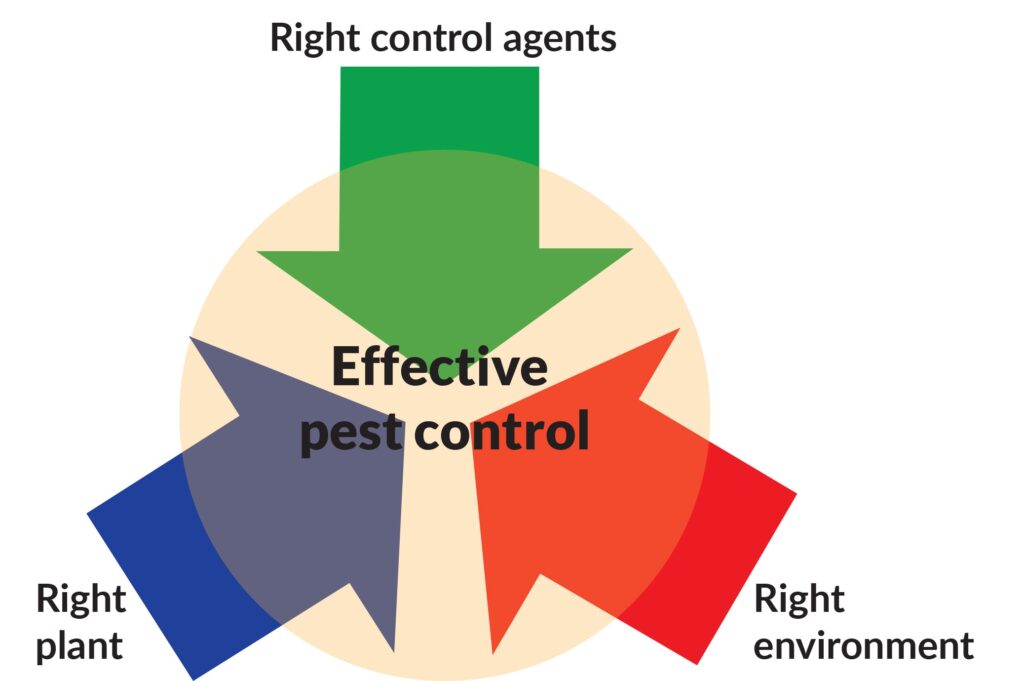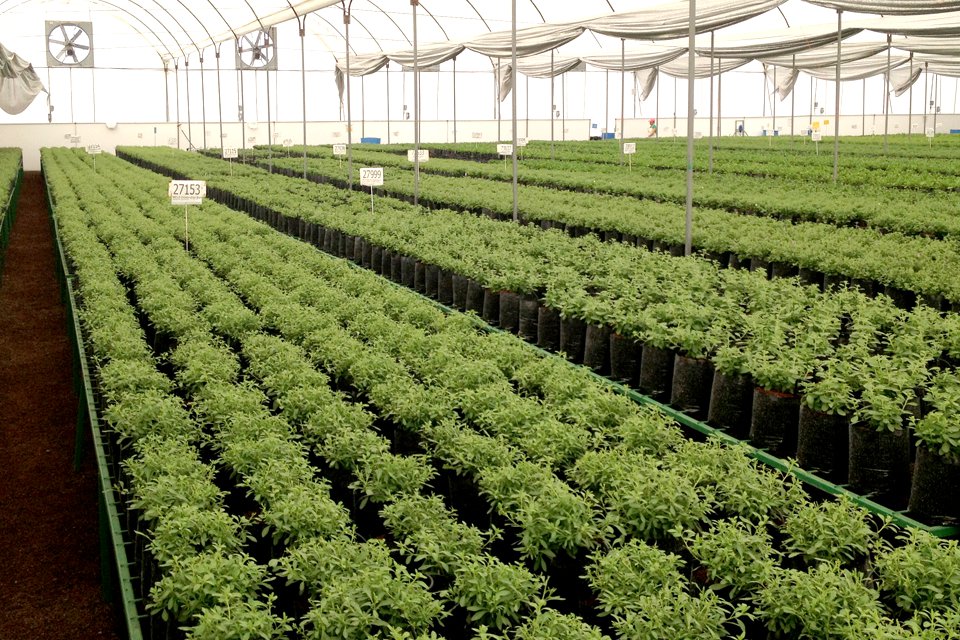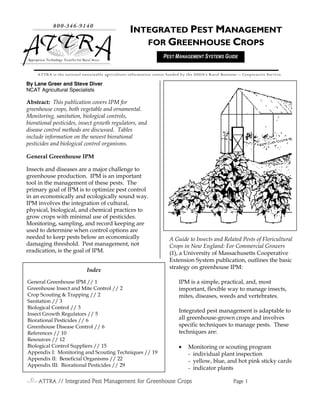
You’ve built the perfect greenhouse, filled with lush green plants and blossoming flowers. But as any experienced gardener knows, pests can quickly turn that paradise into a nightmare. With pests wreaking havoc on your precious plants, it’s time to take control and develop a foolproof pest management plan. This article will guide you through the essential steps you need to take to create a pest management plan that will keep your greenhouse thriving and pest-free. From identifying common pests to implementing eco-friendly solutions, you’ll learn everything you need to know to protect your beloved plants and maintain a healthy and vibrant greenhouse environment.
This image is property of www.canr.msu.edu.
Identify Potential Pests
Understanding Common Greenhouse Pests
When developing a pest management plan for your greenhouse, the first step is to familiarize yourself with the common pests that can affect your plants. Common greenhouse pests include aphids, whiteflies, thrips, spider mites, and fungus gnats. By understanding these pests and their behavior, you can better prepare for their prevention and control.
Conducting Regular Pest Surveillance
To effectively manage pests in your greenhouse, it is crucial to conduct regular pest surveillance. This involves actively monitoring your plants for any signs of infestation or pest damage. By closely observing the leaves, stems, and other plant parts, you can quickly identify the early signs of pest presence and take appropriate action before the infestation becomes severe.
Monitoring Pest Population Levels
Monitoring pest population levels is essential to determine the severity of infestation and to make informed decisions regarding pest control measures. This can be done by using sticky traps, pheromone traps, or other monitoring devices specifically designed for greenhouse pests. Regularly checking these traps and recording the number of pests caught will help you assess the effectiveness of your pest management strategies and make necessary adjustments.
Assess Potential Risks
Identifying Vulnerable Plants
Different plant species may have varying susceptibilities to pests. Identifying which plants are more vulnerable to certain pests can help you prioritize your pest management efforts. Some plants may also be more valuable or have particular importance, making them a higher priority for protection against pests. By recognizing the vulnerabilities of your plants, you can target your preventive measures more effectively.
Analyzing Environmental Factors
Environmental factors such as temperature, humidity, and light levels can significantly influence pest populations in your greenhouse. Pests thrive under certain conditions, and by analyzing these factors, you can predict when and where pest infestations are likely to occur. monitoring and adjusting these environmental factors can help create an unfavorable environment for pests, reducing the risks of infestation.
Predicting Seasonal Pest Infestations
Many pests have specific seasonal patterns, and being aware of these patterns can help you anticipate and prevent infestations. By tracking previous pest occurrences and consulting local resources or experts, you can develop a timeline of potential pest outbreaks throughout the year. This knowledge will allow you to implement preventive measures in advance, minimizing the impact of pests on your greenhouse.
Implement Preventive Measures
Maintaining Proper Greenhouse Sanitation
Proper greenhouse sanitation is crucial for preventing pest infestations. Regularly cleaning the greenhouse, removing plant debris, and sanitizing equipment and tools can create an unfavorable environment for pests to thrive. Eliminating potential breeding grounds and food sources will help minimize the risk of infestation. Additionally, practicing good hygiene by washing hands and using clean equipment when handling plants will prevent the spread of pests.
Establishing Physical Barriers
Physical barriers can be an effective method of preventing pests from entering your greenhouse. Installing screens or nets on windows and vents can keep flying insects out, while sealing gaps and cracks in the structure can prevent crawling pests from infiltrating. Furthermore, placing sticky traps or barriers around the base of plants can prevent pests from reaching and damaging your crops.
Implementing Integrated Pest Management (IPM)
Integrated Pest Management (IPM) is a holistic and sustainable approach to pest control that combines various strategies to minimize reliance on pesticides. By utilizing a combination of cultural, biological, and chemical control methods, IPM aims to effectively manage pests while reducing the risks to human health and the environment. Implementing IPM involves regularly monitoring pest populations, using beneficial insects for biological control, and selectively applying pesticides as a last resort.
Utilize Biological Controls
Understanding Beneficial Insects
Beneficial insects play a vital role in natural pest control by preying on or parasitizing harmful pests. By understanding the life cycles and behaviors of beneficial insects, you can introduce them into your greenhouse to help control pest populations. Ladybugs, lacewings, and parasitic wasps are examples of beneficial insects commonly used for biological control in greenhouses. These insects offer a sustainable and environmentally friendly approach to pest management.
Introducing Predators and Parasitoids
Predators and parasitoids are specific types of beneficial insects that can be introduced into your greenhouse to target and control specific pest species. Predators actively feed on pests, while parasitoids lay their eggs inside the pest, ultimately killing it. By releasing these natural enemies of pests, you can establish a balanced ecosystem within your greenhouse and reduce the need for chemical pesticides.
Implementing Microbial Pest Control
Microbial pest control involves the use of naturally occurring microorganisms, such as fungi or bacteria, to target and control pests. These microorganisms infect pests, causing diseases or impairing their ability to reproduce. Microbial pesticides are often selective, meaning they target specific pests while having minimal impact on beneficial insects or the environment. Implementing microbial pest control can be an effective and environmentally friendly method of managing pests in your greenhouse.

This image is property of www.greenhousecanada.com.
Apply Chemical Controls
Choosing the Right Pesticides
While chemical control should be used as a last resort, there may be instances where it becomes necessary. When selecting pesticides, it is crucial to choose products that are specifically labeled for use in greenhouses and are registered for the target pests. Consider the mode of action, application method, and potential risks associated with each pesticide. Opt for products with the least impact on beneficial insects and the environment.
Following Proper Application Techniques
Applying pesticides correctly is essential to ensure their effectiveness and minimize potential risks. Follow the instructions on the pesticide label carefully, including the appropriate dosage, timing, and application method. Adhere to safety precautions, such as wearing protective clothing and using proper equipment. Avoid unnecessary pesticide applications and carefully target only the affected areas to prevent unnecessary harm to the plants and the environment.
Ensuring Safe Handling and Storage
Proper handling and storage of pesticides are critical for the safety of both workers and the environment. Store pesticides in a secure area with restricted access and separate them from other chemicals or fertilizers. Follow local regulations and dispose of empty pesticide containers correctly. Regularly inspect and maintain application equipment to ensure it is functioning properly and preventing leaks or spills.
Develop a Monitoring Program
Setting Up Traps and Monitoring Devices
To effectively monitor pest populations in your greenhouse, set up traps and monitoring devices strategically. Sticky traps can capture flying insects, while pheromone traps can attract and trap specific pests. Additionally, using yellow or blue sticky cards can help monitor population levels of certain pests. Place these traps in strategic locations throughout your greenhouse, particularly near vulnerable plants or areas where pests are likely to enter.
Creating a Monitoring Schedule
Establishing a monitoring schedule is essential to ensure regular surveillance and timely pest management interventions. Determine the frequency at which you will inspect traps, monitor plant health, and assess pest populations. Consider the life cycles of the pests you are targeting and align your monitoring schedule accordingly. Timely detection and intervention can help prevent pest population explosions and minimize the need for chemical controls.
Recording and Analyzing Data
Maintaining accurate records is crucial for evaluating the effectiveness of your pest management plan over time. Record the results of your monitoring activities, including pest counts, plant damage assessments, and any control measures applied. Analyze this data periodically to identify trends, assess the success of your preventive measures, and make informed decisions regarding adjustments to your pest management strategies.

This image is property of www.greenhousegrower.com.
Educate and Train Staff
Providing Basic Pest Identification Training
Training your staff on pest identification is essential for effective pest management. Provide them with the knowledge and skills to recognize common pests, their life cycles, and the signs of infestation. By empowering your staff with this information, they can actively participate in pest surveillance, timely reporting of pest issues, and the implementation of control measures when necessary.
Teaching Proper Sanitation Practices
Proper sanitation practices are the foundation of any pest management plan. Educate your staff on the importance of maintaining cleanliness in the greenhouse, emphasizing the removal of plant debris, regular cleaning, and disinfection of equipment. Train them on proper waste disposal methods to prevent the accumulation and attraction of pests. By instilling good sanitation practices, you can significantly reduce the risks of pest infestations.
Training on IPM Strategies
Ensure that your staff is trained on the principles and practices of Integrated Pest Management (IPM). Teach them about the cultural, biological, and chemical control methods used in IPM and how they can be implemented in your greenhouse. By promoting a comprehensive understanding of IPM strategies, your staff can actively contribute to the prevention, monitoring, and control of pests without relying solely on chemical pesticides.
Establish Emergency Response Procedures
Creating a Pest Outbreak Response Plan
Even with thorough preventive measures, pest outbreaks can occasionally occur. Develop a pest outbreak response plan to ensure a timely and organized approach to mitigate the impact. Outline the steps to be taken, such as identifying the pest species, determining the extent of infestation, and implementing appropriate control measures. Include protocols for communication, coordination with pest management professionals, and any necessary adjustments to regular operations.
Developing Protocols for Pest Exclusion
Pest exclusion is an essential component of your emergency response procedures. Establish protocols for isolating affected plants, removing heavily infested individuals, and implementing temporary measures to prevent the spread of pests. Consider using physical barriers or quarantine areas to prevent pests from migrating to uninfested plants. By containing the infestation, you can minimize the risk of further damage and potential pest outbreaks.
Setting Up Emergency Communication Channels
Effective communication is crucial during emergency situations. Establish clear communication channels to ensure that all relevant staff members are informed promptly about any pest-related issues or outbreaks. Provide a method for reporting pest sightings or concerns in real-time. This will allow for a swift response and collaborative decision-making, reducing the potential impact of pest infestations on your greenhouse.

This image is property of image.slidesharecdn.com.
Evaluate and Adjust the Plan
Conducting Regular Plan Audits
Regularly evaluate and audit your pest management plan to gauge its effectiveness. Assess whether the implemented strategies are achieving the desired results, reducing pest populations, and minimizing plant damage. Identify any gaps or areas for improvement and develop action plans to address them. By conducting plan audits, you can ensure that your pest management efforts remain efficient and up-to-date.
Monitoring Plan Effectiveness
Continuously monitor and evaluate the effectiveness of your pest management plan. Observe changes in pest population levels, track plant health, and assess the frequency and severity of infestations. Compare these results to your initial baseline data to determine the impact of your preventive measures and control strategies. This ongoing assessment will allow you to make data-driven decisions and refine your plan accordingly.
Making Necessary Adjustments
Based on the evaluation of your plan’s effectiveness, make the necessary adjustments to optimize pest management efforts. Adapt strategies to address any new pest species, seasonal variations, or changes in environmental conditions. Consider the feedback and observations from your staff, as they are on the frontline of pest surveillance. By continuously improving your pest management plan, you can ensure long-term success in protecting your greenhouse.
Consult with Pest Management Professionals
Hiring a Certified Pest Control Advisor
Consulting with a certified pest control advisor can provide invaluable expertise and guidance in developing and maintaining an effective pest management plan. They can help assess your specific greenhouse conditions, advise on pest control strategies, and assist with monitoring and data analysis. Their knowledge and experience can support your efforts in implementing sustainable, safe, and efficient pest management practices.
Seeking Guidance from Agricultural Extension Services
Agricultural extension services are valuable resources for greenhouse operators seeking guidance on pest management. These services are often offered by universities or government organizations and provide information, training, and technical support related to agriculture and horticulture. Contact your local agricultural extension office to access resources, workshops, and experts who can assist with developing and refining your pest management plan.
Collaborating with Entomologists or Horticulturists
Engaging with entomologists or horticulturists can further enhance your pest management strategies. These experts specialize in pest identification, behavior, and control methods. They can provide specific recommendations tailored to your greenhouse and help fine-tune your pest management plan. By collaborating with these professionals, you can tap into their expertise and stay updated on the latest research and developments in the field of pest management.

This image is property of growingspaces.com.


